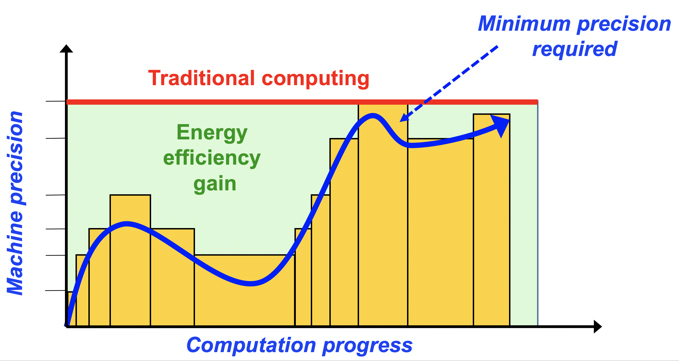Cristiano Malossi, PhD, Manager AI Automation at IBM Research – Zurich tells us what we need to know about the OPRECOMP project that concerns transprecision computing for energy efficiency
During the last 15 years, the demand for new computing strategies driven by energy-efficiency has grown exponentially. In fact, data centres are responsible for between 1-1.5% of global electricity usage with projections that it will grow to 3-13% by 2030.
Flops-per-watt (thus, per-euro) has become de-facto a driving model in hardware design. Results in this direction have been significant, leveraging first multi-core parallelism and then moving toward heterogeneous architectures (e.g., multicore CPU coupled with GP-GPUs). However, these evolutions will not be sufficient in the long-term. To maintain an exponential increase in computational efficiency, we rely either on an unlikely breakthrough discovery in hardware technology or on a fundamental change in computing.
The OPRECOMP Project
OPRECOMP is a four-year research FET project funded under the EU Framework Horizon 2020. The project has a total budget of €6 million and is developed by 10 partners from six countries, led by the scientists at IBM Research Europe based in Zurich, Switzerland.
OPRECOMP aims at demolishing the ultra-conservative “precise” computing abstraction and replacing it with a more flexible and efficient one, namely transprecision computing. A guaranteed numerical precision of each elementary step in a complex computation has been the mainstay of traditional computing systems for many years. However, to overcome the power wall, a shift from traditional computing paradigms is mandatory.
What is transprecision computing?
Transprecision computing is rooted into the key intuition of exploiting approximation in both hardware and software to boost energy efficiency. While this is clearly tied to the rapidly developing research area known as “Approximate computing”, a transprecision computing framework goes beyond the state-of-the-art along several axes, and more precisely:
- Controls approximation adaptively in space and time (when and where), at a fine grain through multiple hardware and software feedback control loops.
- Optimises energy-consumption by accounting for user and application requirements: in other words, it does reduce power/energy consumption without compromising precision at the application level.
- Takes inspiration from nature by defining computing architectures that operate with a smooth and a wide range of precision versus cost trade-off curve.
- Address a wide range of problems with a unified framework and approach and is not tight to a specific application: in other words, enable adoption and reuse.

Challenge and mission
The key barrier to widespread adoption of classic approximate computing is the lack of an application-to-hardware framework for managing precision without compromising on application quality. Automation is key in that respect: until users will need to manually develop and tune approximate computing implementations (including manually checking that the introduced approximations keep the overall error under control), this computing paradigm will not be used outside of a small set of applications.
The mission of OPRECOMP is to demonstrate that with proper hardware and software support based on a transprecision computing framework, we can apply transprecision computing to a wide set of applications including those in the domains of the Internet of things (IoT), Big Data Analytics, Deep Learning, and High-Performance Computing (HPC) simulations. This is achieved by a fine-grained and distributed control of hardware operation coupled with scalable, feedback based runtimes and a programming model, enabling on-line tracking of error metrics and modulation of operating parameters to meet quality-of-results at the application level.
Innovation and the future
By combining together into a seamless design transprecision, advances in devices, circuits, software tools, and algorithms, major energy efficiency improvements can be achieved, even when there is no freedom to relax the end-to-end application quality of results. The avenue in front of this new computing paradigm is a still long one, however, the OPRECOMP project has already demonstrated its tremendous potential through many examples, and just to cite a few of them:
- Two hardware demonstrators, based on PULP and POWER, where all OPRECOMP algorithms and applications are demonstrated, with energy savings often near 10x and in some cases up to 100x.
- 12 popular optimised algorithms recurring in many applications, including backpropagation for CNN/BLSTM neural networks, PageRank, and linear solvers, among others.
- An easy to use emulation library – FloatX – that enables users not familiar with lower precision arithmetic to experiment with it in their applications, changing only a few lines of code.
The OPRECOMP consortium is preparing an open-day to be hosted at ETH – Zurich in February 2021. The open-day will include an exposition with the latest demonstrators and the possibility for visitors to discuss directly with the experts. More information will be available on the OPRECOMP website soon.
Acknowledgements
The project OPRECOMP acknowledges the financial support of the Future and Emerging Technologies (FET) programme within the European Union’s Horizon 2020 research and innovation programme, under grant agreement No. 732631.
*Please note: This is a commercial profile











